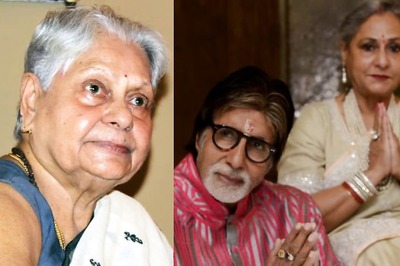
views
Ralegan Siddhi (Maharashtra): When an Army jeep driver returned to this village after surviving strafing by enemy planes, being the driving force behind a major anti-corruption campaign was not on his agenda.
But 72-year-old Kisan Baburao Hazare, famously known as Anna Hazare, into the third day of his fast unto death for a stronger anti-corruption law, has become the most visible face of the movement that is garnering growing support.
Hazare was born into an agrarian family in Ralegan Siddhi, a village in Ahmednagar district of western Maharashtra on June 15, 1938. After the Indo-China war in 1962, the Indian government had made an appeal to the youth to join the defence services for the country.
Hazare was one of those who responded and joined the army in 1963. During the India-Pakistan war, he was posted in the Khemkaran sector, where Pakistani fighter jets bombarded Indian positions. Even though Hazare had a lucky escape, he saw his colleagues die before him leading to his decision of remaining a bachelor.
During his days in the Army in the 1960s as a truck driver, he spent a lot of time reading about Swami Vivekananda, Mahatma Gandhi and Acharya Vinoba Bhave. Hazare returned to Ralegan Siddhi village in 1975, after seeking voluntary retirement from the Army after 15 years of service. He was faced with a village in the grip of drought, poverty, crimes and alcoholism.
He inspired villagers to join him in building canals and bunds to hold rainwater which increased irrigation possibilities in the village. Literacy programmes were also taken up transforming the village into a model village. This experiment made him famous across the country.
During that time, Anna first came across a case of corruption by forest officers in Maharashtra and went on an indefinite hunger strike in Alandi near Pune. His agitation jolted the authorities into taking action against the erring officers.
He formed the 'Bhrashtachar Virodhi Jan Andolan' in 1991 that gradually spread across the state. He launched a campaign demanding the Right to Information in 1997 that resulted in the Maharashtra government legislating an Act, which was subsequently adopted by the Centre in 2005.
Hazare, who lives in a small room attached to the Yadavbaba temple in his village, has already tasted success, with Agriculture Minister Sharad Pawar quitting the Group of Ministers on corruption issue after the Gandhian called him corrupt.
After pledging to serve society in his second lease of life, Hazare has, over the last three decades, brought Maharashtra s political establishment to its knees, leading to resignation of ministers in both Shiv Sena-BJP and Congress-NCP governments.
After Mahatma Gandhi, Hazare is among those who have used hunger strike as a potent weapon. In his public life, he has resorted to hunger strike eight times. In 1995, Hazare's fast led to the exit of two state Cabinet Ministers, labelled corrupt by the Gandhian and the Sena-BJP government was forced to drop them.
Hazare did not spare the Congress-NCP regime either and in 2003, went on hunger strike against four ministers, alleging they indulged in corruption. A commission under retired justice PB Sawant was constituted to probe corruption charges against the ministers.
Hazare's persistent attack on those corrupt also earned him foes. In 2009, two persons arrested for killing Congress leader Pawanraje Nimbalkar said there was a contract given out to kill the Magsaysay Award winner. His distractors point out that while being at the loggerheads with the government, the recipient of Padma Shri, has accepted the hospitality of the government, joined government panels and used government vehicles and officers.
However, there are also cases of foes-turned-friends as seen by Shiv Sena chief Bal Thackeray announcing his support for Hazare's hunger strike in Delhi. Not long ago, it was the same Thackeray who had taunted Hazare as 'Gandhi with a crooked face'.
The only family members he has are two married sisters. One lives in Mumbai and another in Sangamner in Ahmednagar district. His mother Laxmibai died in 2002.




















Comments
0 comment